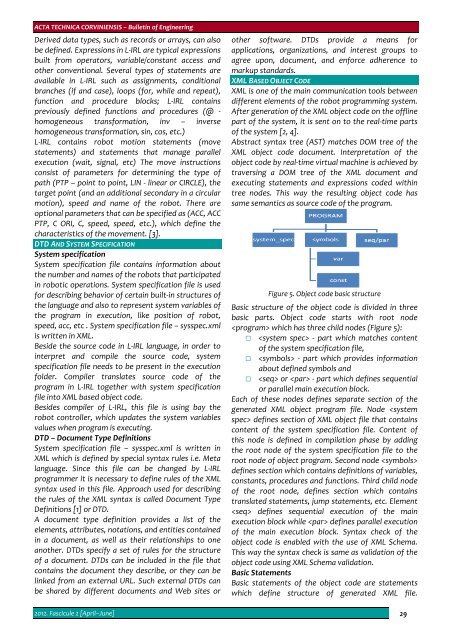Editorial & Advisory Board - Acta Technica Corviniensis
Editorial & Advisory Board - Acta Technica Corviniensis
Editorial & Advisory Board - Acta Technica Corviniensis
You also want an ePaper? Increase the reach of your titles
YUMPU automatically turns print PDFs into web optimized ePapers that Google loves.
ACTA TECHNICA CORVINIENSIS – Bulletin of Engineering<br />
Derived data types, such as records or arrays, can also<br />
be defined. Expressions in L‐IRL are typical expressions<br />
built from operators, variable/constant access and<br />
other conventional. Several types of statements are<br />
available in L‐IRL such as assignments, conditional<br />
branches (if and case), loops (for, while and repeat),<br />
function and procedure blocks; L‐IRL contains<br />
previously defined functions and procedures (@ ‐<br />
homogeneous transformation, inv – inverse<br />
homogeneous transformation, sin, cos, etc.)<br />
L‐IRL contains robot motion statements (move<br />
statements) and statements that manage parallel<br />
execution (wait, signal, etc) The move instructions<br />
consist of parameters for determining the type of<br />
path (PTP – point to point, LIN ‐ linear or CIRCLE), the<br />
target point (and an additional secondary in a circular<br />
motion), speed and name of the robot. There are<br />
optional parameters that can be specified as (ACC, ACC<br />
PTP, C ORI, C, speed, speed, etc.), which define the<br />
characteristics of the movement. [3].<br />
DTD AND SYSTEM SPECIFICATION<br />
System specification<br />
System specification file contains information about<br />
the number and names of the robots that participated<br />
in robotic operations. System specification file is used<br />
for describing behavior of certain built‐in structures of<br />
the language and also to represent system variables of<br />
the program in execution, like position of robot,<br />
speed, acc, etc . System specification file – sysspec.xml<br />
is written in XML.<br />
Beside the source code in L‐IRL language, in order to<br />
interpret and compile the source code, system<br />
specification file needs to be present in the execution<br />
folder. Compiler translates source code of the<br />
program in L‐IRL together with system specification<br />
file into XML based object code.<br />
Besides compiler of L‐IRL, this file is using bay the<br />
robot controller, which updates the system variables<br />
values when program is executing.<br />
DTD – Document Type Definitions<br />
System specification file – sysspec.xml is written in<br />
XML which is defined by special syntax rules i.e. Meta<br />
language. Since this file can be changed by L‐IRL<br />
programmer it is necessary to define rules of the XML<br />
syntax used in this file. Approach used for describing<br />
the rules of the XML syntax is called Document Type<br />
Definitions [1] or DTD.<br />
A document type definition provides a list of the<br />
elements, attributes, notations, and entities contained<br />
in a document, as well as their relationships to one<br />
another. DTDs specify a set of rules for the structure<br />
of a document. DTDs can be included in the file that<br />
contains the document they describe, or they can be<br />
linked from an external URL. Such external DTDs can<br />
be shared by different documents and Web sites or<br />
other software. DTDs provide a means for<br />
applications, organizations, and interest groups to<br />
agree upon, document, and enforce adherence to<br />
markup standards.<br />
XML BASED OBJECT CODE<br />
XML is one of the main communication tools between<br />
different elements of the robot programming system.<br />
After generation of the XML object code on the offline<br />
part of the system, it is sent on to the real‐time parts<br />
of the system [2, 4].<br />
Abstract syntax tree (AST) matches DOM tree of the<br />
XML object code document. Interpretation of the<br />
object code by real‐time virtual machine is achieved by<br />
traversing a DOM tree of the XML document and<br />
executing statements and expressions coded within<br />
tree nodes. This way the resulting object code has<br />
same semantics as source code of the program.<br />
Figure 5. Object code basic structure<br />
Basic structure of the object code is divided in three<br />
basic parts. Object code starts with root node<br />
which has three child nodes (Figure 5):<br />
‐ part which matches content<br />
of the system specification file,<br />
‐ part which provides information<br />
<br />
about defined symbols and<br />
or ‐ part which defines sequential<br />
or parallel main execution block.<br />
Each of these nodes defines separate section of the<br />
generated XML object program file. Node defines section of XML object file that contains<br />
content of the system specification file. Content of<br />
this node is defined in compilation phase by adding<br />
the root node of the system specification file to the<br />
root node of object program. Second node <br />
defines section which contains definitions of variables,<br />
constants, procedures and functions. Third child node<br />
of the root node, defines section which contains<br />
translated statements, jump statements, etc. Element<br />
defines sequential execution of the main<br />
execution block while defines parallel execution<br />
of the main execution block. Syntax check of the<br />
object code is enabled with the use of XML Schema.<br />
This way the syntax check is same as validation of the<br />
object code using XML Schema validation.<br />
Basic Statements<br />
Basic statements of the object code are statements<br />
which define structure of generated XML file.<br />
2012. Fascicule 2 [April–June] 29

















